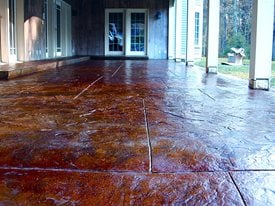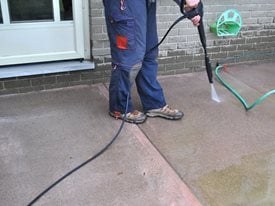
Distinctive Concrete of New England in Rowley, MA
Cleaning a concrete patio should be done on a regular basis just like any other home maintenance. The frequency will depend on how much exposure the patio gets to foot traffic, water, and any chemicals.
Get help from a contractor offering concrete cleaning near me.
HOW TO CLEAN A CONCRETE PATIO
Cleaning your patio without a pressure washer
General patio cleaning does not require special tools or equipment and can be done in just 3 easy steps:
- Rinse dirt/debris off the concrete surface with a garden hose.
- Apply a small amount of liquid dish soap and scrub with a push broom.
- Rinse well with a garden hose until there is no sign of soapsuds.
Tip: If you’re going to be resealing your patio, wait 24 hours after cleaning for it to air dry. If you’re in a hurry, a leaf blower can be used to speed up the drying process.
Related:
Cleaning Stamped Concrete
How to Clean Colored Concrete

Akvals / Shutterstock
Pressure washing your patio
Pressure or power washing is a popular method for outdoor cleaning projects. You can purchase or rent a machine powered by either gas or electricity to clean your patio. Be careful though, if the pressure setting is too high or the range too close, you could actually damage the concrete.
How to clean dog urine from a concrete patio
Dog urine and other organic stains can be tough to remove from concrete. Concrete degreaser, acid or soap will do next to nothing to remove these types of stains, the best cleaner to use is one with bleaching action or ammonia.
How to clean a concrete patio of mold
If your patio is in a wet, shady spot, you may have issues with mold. Not only does mold make your patio look bad, but it also poses health and safety issues. Learn about the best cleaning solutions for a moldy patio: How to Clean Mold Off Concrete.
Removing fertilizer stains from a concrete patio
Fertilizer from your lawn or planters can leave stains on concrete. The ingredients in fertilizer penetrate and react with the cement, causing a permanent color change. Try using a clear white vinegar, diluted 50:50 with water to bring out the stains. Test in a small area first and be aware that the acid may etch or change the profile of the concrete in the areas you clean.